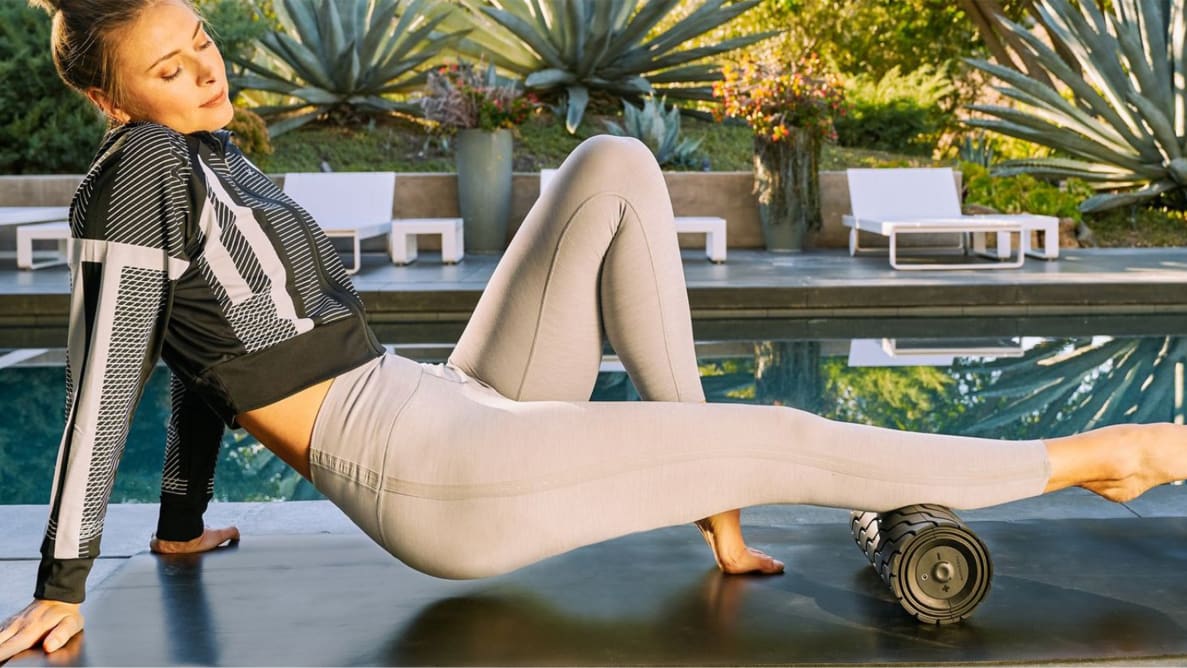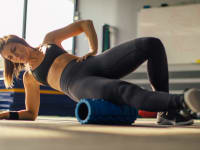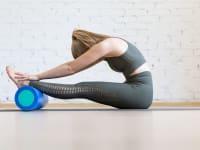Pros
-
Five speed settings
-
Therabody app-compatible
-
Feels great on sore muscles
Cons
-
Costs more than a typical foam roller
-
May not have added benefits
About the Therabody Wave Foam Roller
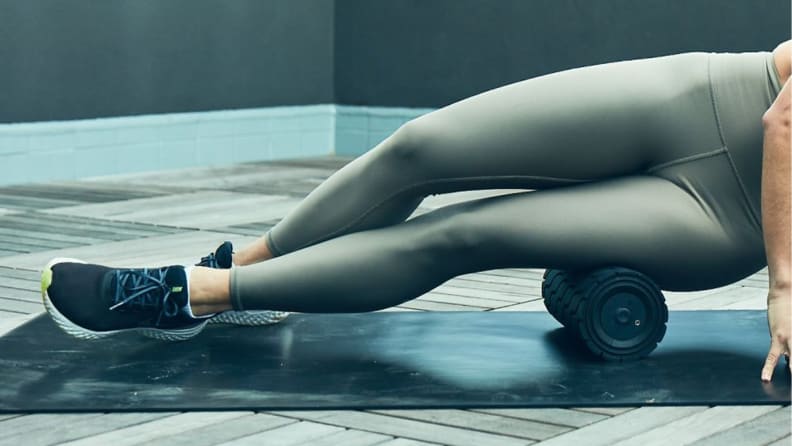
The Therabody Wave Roller combines self-myofascial rolling with percussive therapy.
The Therabody Wave combines self-myofascial massage with percussive therapy to provide a more intense—and possibly more enjoyable—workout cooldown or recovery session. The one-foot-long roller has five intensity levels and a three-hour battery life—though, of course, you could use it without the vibrations for as long as you like.
The surface of the Wave is less dense—A.K.A. more squishy—than other foam rollers I’ve used in the past, but not so soft that I couldn’t feel the myofascial massage from rolling with it sans vibration. It also has narrow, wave-shaped cutouts in the foam, designed to provide contrasting texture.
The Wave has buttons on the end to control its vibration intensity. But like the Therabody massage guns, the Wave can also connect to the Therabody app via Bluetooth. The app guides users through pre-set warm-up and recovery sessions for various sports and muscle groups, and makes it easy to get a thorough rolling session.
Foam rolling is great for muscle recovery, as it can speed up the process by reducing soreness, improving circulation, and improving your range of motion and flexibility. Similarly, percussive therapy can boost muscle recovery and improve range of motion—not to mention, also soothe sore muscles. By Therabody combining self-myofascial rolling and percussive therapy, you may get the benefits of both in one device—or at least, that’s what the brand claims.
What we like about the Wave
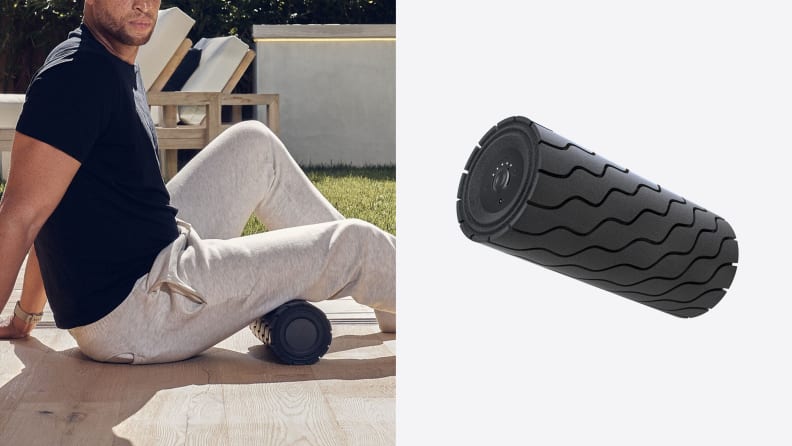
The main draw of the Wave is it feels great on tight muscles.
It feels great on sore muscles
The main reason I enjoyed using the Wave: It felt amazing. Typically, using a foam roller is uncomfortable. And even though I know it’s good for me, I don’t look forward to it. The Wave’s vibrations made rolling much more pleasant, and after a few sessions, I found myself looking forward to my cool-downs, which I typically half-complete out of impatience or discomfort. Because the Wave is less dense than my own roller, it didn't dig in as firmly, but I felt the vibrations deeper in my muscles for an enjoyable massage sensation that helped alleviate my post-exercise soreness.
The excellent app makes it easy to use
It’s easy to turn on the roller, adjust the intensity settings, and get rolling. But I especially love that it connects to the Therabody app for guidance. After exercising, I often find myself rolling out the main muscle groups for whatever amount of time feels right and calling it a day. With the app, I can find a session to match my workout, and it shows me what muscles to roll, how to roll them, and for how long.
Most of the app’s sessions range from three to five minutes, and in my testing, I typically completed one or two followed by some free rolling after a workout. The app shows you the movements ahead of time so you know what to expect. Additionally, you can customize your routine by adjusting the intensity levels either on the Wave or the app, giving yourself up to a 15-second break between movements to get situated, and setting transition notifications so you don’t miss a cue. These features kept me from wasting any of the time I was supposed to be rolling shuffling around with the equipment.
What we don’t like about the Wave
It may not be more beneficial than a regular foam roller
While both self-myofascial rolling and percussive therapy can relax the muscles, improve recovery, and reduce soreness, you don’t need a smart foam roller to get these benefits. Furthermore, there’s no evidence that supports the idea that a vibrating foam roller is any better than the standard hunk of foam.
It’s well known that properly stretching, foam rolling, and using a massage gun can all benefit your muscles and help you recover post-workout, says Kelsey Decker, NSCA-CPT and education coordinator at StretchLab, but a vibrating foam roller isn’t necessarily better. “Vibrating foam rollers apply both concepts of vibration, trigger point release, and decongesting the area,” Decker says. “It comes down to personal preference on what may feel best for your body.”
Should you buy the Wave?
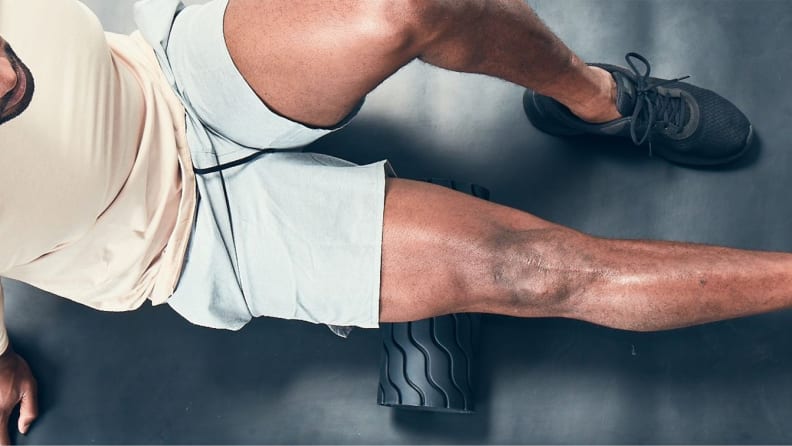
If you typically skip your cool-downs, the Wave could motivate you to stretch and roll.
Maybe, if you hate foam rolling
The Wave’s cushioned exterior and relaxing vibrations made me look forward to using it. As someone who tends to rush through my warmup and spend my cool-down scrolling through my phone, having a device that made me stop skipping these steps was a win.
However, the Wave costs $149, and though the vibration-myofascial massage combo feels really nice, it doesn’t necessarily have any more benefits than a traditional foam roller, or a traditional foam roller followed up with a massage gun (which, arguably, has a similar or higher sticker price).
Bottom line: If you don’t enjoy typical foam rollers, but think a massaging foam roller is just the ticket—and in your budget—you may want to consider the Wave.
Meet the tester

Esther Bell
Senior Staff Writer, Health and Fitness
Esther is a writer at Reviewed covering all things health and fitness.
Checking our work.
Our team is here to help you buy the best stuff and love what you own. Our writers, editors, and experts obsess over the products we cover to make sure you're confident and satisfied. Have a different opinion about something we recommend? Email us and we'll compare notes.
Shoot us an email